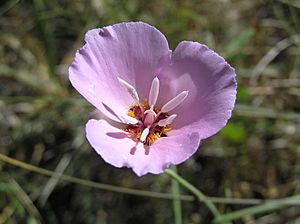Palmer's mariposa lily facts for kids
Quick facts for kids Palmer's mariposa lily |
|
|---|---|
 |
|
| Calochortus palmeri var munzii | |
| Conservation status | |
| Scientific classification | |
| Genus: |
Calochortus
|
| Species: |
palmeri
|
| Synonyms | |
|
|
The Palmer's mariposa lily (scientific name: Calochortus palmeri) is a beautiful flowering plant. It belongs to the lily family. People sometimes call it the "strangling mariposa" too.
This special lily only grows in California. It is found in the Transverse Ranges and Peninsular Ranges of Southern California. You can see it in counties like Santa Barbara, Ventura, Los Angeles, and San Diego. There's also a small group reported in San Benito County.
What Does Palmer's Mariposa Lily Look Like?
The Palmer's mariposa lily is a perennial plant. This means it lives for more than two years. It grows a straight stem that can reach up to 60 centimeters (about 2 feet) tall. The stem often has branches.
Leaves and Flowers
At the bottom of the plant, there is a long leaf. This basal leaf is usually 10 to 20 centimeters long. It dries up by the time the plant flowers.
The plant produces 1 to 6 flowers. These flowers stand upright and look like open bells. Each flower has three sepals, which are leaf-like parts that protect the bud. These sepals are about 3 centimeters long and have brown speckles.
The flowers also have three wider petals. Each petal is 2 or 3 centimeters long. The petals can be white or a light lavender color. At the base of the petals, you might see yellow or purple hairs. Some varieties of the flower do not have these hairs.
Types of Palmer's Mariposa Lily
There are two main types, or varieties, of Calochortus palmeri:
- Munz's mariposa lily (Calochortus palmeri var. munzii): This variety is rarer. It is only found in the Peninsular Ranges in Riverside and San Diego Counties.
- Palmer's mariposa lily (Calochortus palmeri var. palmeri): This is the more common variety. It grows naturally in the Transverse Ranges.


